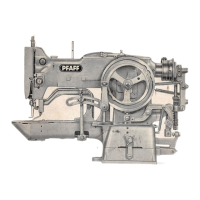27.
Adjusting
the
Tripping
Lever
Tripping
dog
Li
(Fig.
23),
which
is located at the
front
end of the
tripping
lever,
can be
adjusted vertically.
Set
it so that the
stop
tripping
segment
on the rim of the feed
cam
depresses the
tripping
dog far enough to ensure that the machine
will
be stopped secu
rely.
As a general
rule,
there should be a clearance of about
Vb
on an
inch
(3.5
millime
ters) between the tripping dog and the rim of the feed cam when the machine
has
stopped
(Fig. 23).
28. Adjusting
the
Stop
Tripping
Segments
The number of stop tripping segments which are arranged on the rim of the feed cam
varies with each
subclass
and
ranges
from 1 to 6.
To
adjust
the
stop
tripping
segments,
proceed
as
follows:
Turn the
driving
pulley
until
the
tripping
segment to be adjusted
(Mi
in
Fig.
5) has just
passed
tripping
dog
Li
(Fig.
23)
and the stop
link
has snapped into the groove of the
stop cam. When the machine has stopped, tripping dog Li should be positioned just
behind
the stop
tripping
segment,
without
touching
it.
On restarting the
machine,
trip
ping dog Li should contact the rim of the feed cam instantly.
If
the stop
tripping
segment needs
adjustment,
loosen
the
two
screws n
(Fig.
5) and
move the segment back or forth on the
rim
of the cam, as required.
If
the
feed
cam
has
more
than
one
stop
tripping
segment,
each
has
to beset
separately.
29. Timing
the
Thread
Nipper
The needle thread must be trapped when the machine stops. If this condition is not
met, adjust by loosening screw e
(Fig.
18) and
moving
finger f on tripping lever c as
follows:
Toward
you
Needle
thread
Is
trapped
earlier
The
finger
is positioned correctly if Its tapered side just slips over the front edge into
the
recess
on the rim of the cam when the machine stops.
Another rule
that
must be
observed
is
that
the
needle
thread
must
be
released
before
the needle has reached the lowest point of its stroke when making the first stitch. As
the sewing cycle continues, the thread should remain loose until the take-up lever has
reached a point about Vu" (15 millimeters) below the highest point of its stroke. This
condition
also
applies
to
the
initial
phase
of the
second
stitch,
whereas
for all
succes
sive
stitches
the
thread
nipper
remains
inactive. i
If the above condition is not
met,
adjust by loosening the two set screws and
moving
thread nipper tripping
segment
h (Fig. 18), as follows:
Over
from
you
Needle
thread
Is
released
earlier
Although the
correct
pressure
of the thread nipper Is normally established by trial and
error,
the
following
rule
may
be
helpful:
I
The
pressure
Is
correct
if
the
thread
can
just
be
pulled
through
the
thread
nipper
without
breaking.
The pressure Is regulated by stop screw d (Fig. 18). Some bartacks which feature very
long crosswise stitches (without Intermediate stitches) require a sufficiently long
end
of
thread
with which to begin
the
tack. On
machines
making
such
tacks
finger f
should
be
pushed
back
slightly
so
that
it
can
fall
earlier
into
the
recess
on
the
rim
of
the
cam.
If
there
are
several
thread
nipper
segments
arranged
on
the
feed cam,
each
has
to be
adjusted
separately.
30.
Changing
the
Buffer
Spring
A powerful buffer
spring
is
located
in
the
hollow driving pulley
and
serves
to
absorb
the
momentum
of
the
machine
when
It
stops.
If
the
spring
works
correctly,
the
ma
chine is
slowed
down
first
and
stopped
only when
the
needle
bar
has
passed
the
high
est point of its stroke and descended V8"-Vu"
(3-5
millimeters) and the take-up lever
*•-
i'-'
Fig. 25

